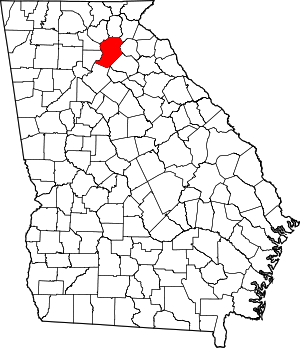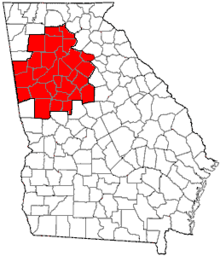Gainesville, Georgia
The city of Gainesville is the county seat of Hall County, Georgia, United States.[6] As of the 2010 census, the city had a population of 33,804.[7] By 2019 the population had risen to an estimated 43,232.[8] Because of its large number of poultry processing plants, it is often called the "Poultry Capital of the World." Gainesville is the principal city of, and is included in, the Gainesville, Georgia Metropolitan Statistical Area, which is included in the Atlanta-Sandy Springs-Gainesville, Georgia Combined Statistical Area.
Gainesville, Georgia | |
|---|---|
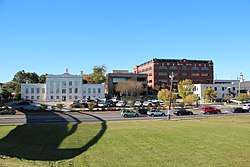 Downtown Gainesville | |
| Nicknames: "Queen City of the Mountains", "Poultry Capital of the World"[1] | |
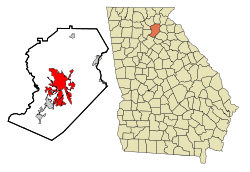 Location in Hall County and the state of Georgia | |
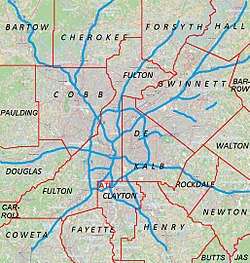 Gainesville Gainesville in Metro Atlanta | |
| Coordinates: 34°18′16″N 83°50′2″W | |
| Country | United States |
| State | Georgia |
| County | Hall |
| Gainesville | 1818 |
| Named for | Edmund P. Gaines |
| Government | |
| • Type | Popular vote democracy |
| • Mayor | Danny Dunagan |
| Area | |
| • City | 34.90 sq mi (90.38 km2) |
| • Land | 32.95 sq mi (85.34 km2) |
| • Water | 1.94 sq mi (5.03 km2) |
| Elevation | 1,250 ft (381 m) |
| Population (2010) | |
| • City | 33,804 |
| • Estimate (2019)[3] | 43,232 |
| • Density | 1,312.01/sq mi (506.57/km2) |
| • Metro | 179,684 |
| Time zone | UTC-5 (EST) |
| • Summer (DST) | UTC-4 (EDT) |
| Area code(s) | 770 |
| FIPS code | 13-31908[4] |
| GNIS feature ID | 0355972[5] |
| Website | www |
History
Gainesville was established as "Mule Camp Springs" by European-American settlers in the early 1800s. Less than three years after the organization of Hall County on December 15, 1818, Mule Camp Springs was renamed "Gainesville" on April 21, 1821. It was named in honor of General Edmund P. Gaines,[9] a hero of the War of 1812 and a noted military surveyor and road-builder. Gainesville was selected to be the county seat and chartered by the Georgia General Assembly on November 30, 1821.
A gold rush that began in nearby Lumpkin County in the 1830s resulted in an increase in the number of settlers and the beginning of a business community. In the middle of the 19th century, Gainesville had two important events. In 1849, it became established as a resort center, with people attracted to the springs. In 1851, much of the small city was destroyed by fire.
After the Civil War, Gainesville began to grow from 1870. In 1871 the Airline Railroad, later named the Georgia Southern Railroad, began to stop in Gainesville, increasing its ties to other markets and stimulating business and population. It grew from 1,000 in 1870, to over 5,000 by 1900.
By 1898, textile mills had become the primary driver of the economy, with the railroad integral to delivering raw cotton and carrying away the mills' products. With the revenues generated by the mills, in 1902, Gainesville became the first city south of Baltimore to install street lamps.[10] On March 1, 1905, free mail delivery began in Gainesville, and on August 10, 1910, the Gainesville post office was opened. On December 22, 1915, the city's first high-rise, the Jackson Building, had its formal opening. In 1919 Southern Bell made improvements to the phone system.
City services began in Gainesville on February 22, 1873, with the election of a City Marshal, followed by solid waste collection in 1874. In 1890, a bond issue to fund the waterworks was passed, and the original water distribution system was developed.
In 1943, at the height of World War II, Gainesville contributed to the war effort by leasing the airport to the US government for $1.00. The military used it as a naval air station for training purposes. In 1947, the airport was returned to the city of Gainesville, improved by the addition of two 4,000-foot (1,200 m) landing strips (one of which was later lengthened to 5,500 feet (1,700 m)).
After World War II, a businessman named Jesse Jewell started the poultry industry in north Georgia. Chickens have since become the state's largest agricultural crop. This $1 billion a year industry has given Gainesville the title "Poultry Capital of the World".
In 1956, the U.S. Army Corps of Engineers constructed Lake Sidney Lanier, by building Buford Dam on the Chattahoochee River. During the 1996 Summer Olympics, Gainesville served as the venue for the rowing and kayaking medal competitions, which were staged on Lake Lanier.
Gainesville gained accreditation of its Parks and Recreation Department in 2001. This was the third department in the state to be accredited. The Lakeside water treatment plant opened in 2002. The city has sponsored new social activities, including the Spring Chicken Festival in 2003, the Art in the Square gathering in 2004, and "Dredgefest" in 2008.
2008 saw the reopening of the Fair Street Neighborhood Center, the reopening of the Linwood Water Reclamation Facility Grand, and the completion of the Longwood Park Fishing Pier.
Geography
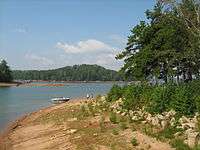
Gainesville is located in central Hall County at 34°18′16″N 83°50′2″W (34.304490, -83.833897).[11] It is bordered to the southwest by the city of Oakwood. Interstate 985/U.S. Route 23 passes through the southern part of the city, leading southwest 54 miles (87 km) to Atlanta and northeast 23 miles (37 km) to Baldwin and Cornelia. U.S. Route 129 runs through the east side of the city, leading north 24 miles (39 km) to Cleveland and southeast 21 miles (34 km) to Jefferson.
According to the United States Census Bureau, the city has a total area of 33.9 square miles (87.7 km2), of which 31.9 square miles (82.7 km2) are land and 1.9 square miles (5.0 km2), or 5.75%, are water.[12]
Nestled in the foothills of the Blue Ridge Mountains, parts of Gainesville lie along the shore of one of the nation's most popular inland water destinations, Lake Lanier. Named after Confederate veteran, Georgia author and musician Sidney Lanier, the lake was created in 1956 when the U.S. Army Corps of Engineers dammed the Chattahoochee River near Buford and flooded the river's valley. Although created primarily for hydroelectricity and flood control, it also serves as a reservoir providing water to the city of Atlanta and is a very popular recreational attraction for all of north Georgia.
Much of Gainesville is heavily wooded, with both deciduous and coniferous trees.
Transportation
Major roads
Pedestrians and cycling
- Highlands to Island Trail (Under construction)[13]
- Midtown Greenway
- Wilshire Trails
Mass transit
- The Gainesville Amtrak station is situated at 116 Industrial Boulevard. Amtrak's Crescent train connects Gainesville with the cities of New York, Philadelphia, Baltimore, Washington, Greensboro, Charlotte, Atlanta, Birmingham and New Orleans. The train arrives once daily in each direction, coming southbound at breakfast time and northbound in the evening.
- Gainesville has a bus transit system, the Gainesville Connection, with 130 stops along three routes through Gainesville.[14] The Hall Area Transit Transportation System began operations in January 2001 with three buses and four mini-buses.[15]
Airport
- Lee Gilmer Memorial Airport (GVL), built in 1940, is a city-owned airport with two runways (5,500 ft and 4,001 ft), and supports air taxi operations, itinerant operations, local operations, and military operations. Aircraft include 116 single engine aircraft, 21 multi-engine aircraft, 2 jet engine aircraft and 1 helicopter.[16] In addition, Gainesville has three heliports, Beaver Trail, Lanier Park Hospital and Latham Creek.
Economy
Poultry farming
The poultry farming industry in Gainesville began to develop after World War II, when Jesse Jewell, a Gainesville feed salesman, began his business. The format he developed was to sell North Georgia farmers baby chicks and feed on credit. When the chicks were grown, Jewell would buy back the adult chickens (broilers) at a price that would cover his costs and guarantee farmers a profit. Once Jewell signed on enough farmers to produce broilers for him, he invested in his own processing plant and hatchery.[17]
As of 2013, poultry farming remains a significant economic driver in Gainesville, representing six of its top ten employers (7,600 employees), nearly one-quarter of the total population in the city in 2010 (and a higher proportion of the working-age population).[18] It is the most well-known business in the area, with statewide revenue exceeding $3 billion. These jobs have attracted numerous Hispanic workers, adding to the diversity of families in the city and county. The proportion of Hispanic and Latino residents is more than 40 percent of the city's population, where the jobs are.
Top employers
According to Gainesville's 2012 Comprehensive Annual Financial Report,[19] the top employers in the city are:
| # | Employer | # of Employees |
|---|---|---|
| 1 | Northeast Georgia Health System | 5,030 |
| 2 | Fieldale Farms | 2,400 |
| 3 | Pilgrim's | 1,600 |
| 4 | Mar-Jac | 1,250 |
| 5 | Kubota | 960 |
| 6 | Coleman Natural | 900 |
| 7 | The Longstreet Clinic | 580 |
| 8 | Koch Foods | 521 |
| 9 | ZF | 440 |
| 10 | MP Equipment | 110 |
Culture
Arts and theater
Gainesville is the home of the Gainesville Theater Alliance (GTA), which is a partnership between Brenau University, the University of North Georgia, Theatre Wings, and the Professional Company. This coalition provides theatrical entertainment for the entire Gainesville area. GTA utilizes both professional and student actors in its productions and their performances have been nationally acclaimed.[20]
The Northeast Georgia History Center is a museum established by Brenau University in Downtown Gainesville that focuses on the heritage of the Northeast Georgia region. Some notable exhibits include the Land of Promise and Northeast Georgia Sports Hall of Fame.[21]
The Arts Council is a non-profit organization focused on providing Gainesville residents with a broad variety of visual, performing, and literary arts. The Atlanta Symphony Orchestra has been known to perform at this location. The Arts Council is located in the Smithgall Arts Center, which is a former two-story train depot that the Arts Council purchased from CSX Transportation in 1992.[22]
The Quinlan Visual Arts Center is a non-profit arts association initially founded as the Gainesville Arts Association in 1942. The Quinlan Visual Arts Center acts as an exhibit, with multiple galleries on display throughout the year, as well as an event center. It is also an affiliate of the Arts Council and provides art classes for both children and adults.[23]
The Gainesville Symphony Orchestra (GSO) was a volunteer orchestra founded in 1982 as the Lanier Symphony Orchestra. However, due to a lack in funding during the Great Recession, the GSO shut down in 2013 after almost 30 years of operation.[24]
Gainesville is also home to the Gainesville Ballet Company which is a partnership with Brenau University and the Gainesville School of Dance. One of their more popular performances throughout the year is Tchaikovsky's The Nutcracker.[25]
Alta Vista Cemetery is a graveyard located just outside Downtown Gainesville. The famous Confederate general James Longstreet is buried here. Other notable gravesites include: several Georgia governors, an astronaut, a rocket scientist, a circus performer, and that of poultry pioneer Jesse Jewell (whom Jesse Jewell Parkway, Gainesville's main thoroughfare, is named after).[26]
Climate
Gainesville has a subtropical climate with mild, yet extremely varying[27] winters and very hot summers.
Winters are generally mild, with average temperature highs in the high 40s to mid 50s and lows in the low to mid 30s. However, temperatures can swing up and down in days, often one after another, since cold fronts and warm fronts visit frequently. It is not uncommon to see 70s for highs two days and temperatures in the teens for lows the next. Annual snowfall only yields an average of 4 inches, and accumulations for more than a day are rare.[28] Gainesville is located in USDA Hardiness Zone 8a, enabling hardy palm trees and cacti to withstand frigid nights. The record low temperature (-14 °F) was recorded in January 1985.
Spring sees highs in the 70s and 80s with lows in the 40s and 50s although March is the wettest month of the year on average.
Summer heat can be intense, but generally highs are in the mid to upper 80s. Gainesville's altitude shaves a few degrees off the summer heat. The area is extremely humid, and the heat index can reach the 100s. The record high (107 °F) was recorded in June and July 1952.
Fall has temperatures similar to spring but with much less humidity, especially later in the season. In late October to November the leaves are in the midst of changing colors to brilliant reds, yellows, golden oranges and purples.
| Climate data for Gainesville, Georgia | |||||||||||||
|---|---|---|---|---|---|---|---|---|---|---|---|---|---|
| Month | Jan | Feb | Mar | Apr | May | Jun | Jul | Aug | Sep | Oct | Nov | Dec | Year |
| Average high °F (°C) | 51 (11) |
56 (13) |
63 (17) |
72 (22) |
80 (27) |
87 (31) |
90 (32) |
90 (32) |
82 (28) |
73 (23) |
60 (16) |
52 (11) |
71 (22) |
| Average low °F (°C) | 32 (0) |
37 (3) |
46 (8) |
51 (11) |
60 (16) |
66 (19) |
68 (20) |
66 (19) |
61 (16) |
51 (11) |
45 (7) |
35 (2) |
52 (11) |
| Source: Weatherbase[29] | |||||||||||||
Severe weather
While Gainesville does not sit in Tornado Alley, a region of the United States where severe weather is common, Supercell thunderstorms can sweep through any time between March and November, being primarily concentrated in the spring. Tornado watches are frequent in the spring and summer, with a warning appearing at least biannually, occasionally with more than one per year.
Tornado activity in the Gainesville area is above Georgia state average and is 108% greater than the overall U.S. average.
Gainesville was the site of the fifth deadliest tornado in U.S. history in 1936,[30] in which Gainesville was devastated and 203 people were killed.[31] Gainesville was also the site of another deadly F4 on June 1, 1903, which killed 98 people.
In April 1974, an F4 tornado 22.6 miles away from the Gainesville city center killed six people and injured thirty. In December 1973, an F3 tornado 2.1 miles away from the city center injured twenty-one people. Both storms caused between $500,000 and $5,000,000 in property damages.
Demographics
| Historical population | |||
|---|---|---|---|
| Census | Pop. | %± | |
| 1860 | 344 | — | |
| 1870 | 472 | 37.2% | |
| 1880 | 1,919 | 306.6% | |
| 1890 | 3,202 | 66.9% | |
| 1900 | 4,382 | 36.9% | |
| 1910 | 5,925 | 35.2% | |
| 1920 | 6,272 | 5.9% | |
| 1930 | 8,624 | 37.5% | |
| 1940 | 10,243 | 18.8% | |
| 1950 | 11,936 | 16.5% | |
| 1960 | 16,523 | 38.4% | |
| 1970 | 15,459 | −6.4% | |
| 1980 | 15,280 | −1.2% | |
| 1990 | 17,885 | 17.0% | |
| 2000 | 25,578 | 43.0% | |
| 2010 | 33,804 | 32.2% | |
| Est. 2019 | 43,232 | [3] | 27.9% |
| U.S. Decennial Census[32] | |||
As of the census[4] of 2010, there were 33,804 people, 11,273 households, and 7,165 families residing in the city. The population density was 1.161.6 people per square mile (450.7/km2). There were 12,967 housing units at an average density of 445.6 per square mile (172.9/km2). The racial makeup of the city was 54.2% White, 15.2% African American, 0.6% Native American, 3.2% Asian, 0.2% Pacific Islander, 23.4% from other races, and 3.2% from two or more races. Hispanic or Latino of any race were 41.6% of the population.
There were 11,273 households out of which 30.3% had children under the age of 18 living with them, 39.3% were married couples living together, 18.2% had a female householder with no husband present, and 36.4% were non-families. 28.9% of all households were made up of individuals and 3.64% had someone living alone who was 65 years of age or older. The average household size was 2.85 and the average family size was 3.55.
Age distribution was 33.9% under the age of 20, 9.5% from 20 to 24, 29.2% from 25 to 44, 16.7% from 45 to 64, and 10.5% who were 65 years of age or older. The median age was 29.5 years. For every 100 females, there were 91.6 males. For every 100 females age 20 and over, there were 84.4 males.
The median income for a household in the city was $38,119, and the median income for a family was $43,734. Males had a median income of $26,377 versus $20,531 for females. The per capita income for the city was $19,439. About 24.9% of families and 29.1% of the population were below the poverty line, including 40.7% of those under age 18 and 17.6% of those age 65 or over.[33] In May 2013, the unemployment rate was 6.9%, less than the overall rate in Georgia of 8.3%, the US of 7.6%[34]
Of the population aged 15 years and over, 31.0% have never been married; 50.0% are now married; 2.4% are separated; 7.7% are widowed; and 9.9% are divorced.
Healthcare
Gainesville is home to the Northeast Georgia Medical Center which houses the Ronnie Green Heart Center.
Government and infrastructure
Arrendale State Prison of the Georgia Department of Corrections is a women's prison located in unincorporated Habersham County, near Alto,[35] and in the Gainesville area.[36]
Education
Three African Americans, Beulah Rucker, E. E. Butler, and Ulysses Byas were educational pioneers in Gainesville and Hall County.[37]
Gainesville City School District
The Gainesville City School District holds pre-school to grade twelve, and consists of five elementary schools, a middle school, and a high school.[38][39] The district has 282 full-time teachers and over 4,438 students.[40] Its lone high school, Gainesville High School boasts several notable alumni, including Deshaun Watson, Texans quarterback, Cris Carpenter, former professional baseball player (St. Louis Cardinals, Florida Marlins, Texas Rangers, Milwaukee Brewers), Tasha Humphrey, professional basketball player, and Micah Owings, current professional baseball player (Arizona Diamondbacks, Cincinnati Reds, San Diego Padres). The mascot for Gainesville High School is the Red Elephant.
Hall County School District
The Hall County School District holds pre-school to grade twelve, and consists of twenty-one elementary schools, six middle schools, and seven high schools.[41] The district has 1,337 full-time teachers and over 21,730 students.[42] The high schools in this district have produced a number of notable alumni including, Connor Shaw, starting quarterback for the University of South Carolina Gamecocks football team; Casey Cagle, Lt. Governor, State of Georgia; James Mills, Georgia State Representative; A.J. Styles, professional wrestler; Deshaun Watson, starting quarterback for the Houston Texans, Mike "MoonPie" Wilson, former NFL football player; Chester Willis, former NFL football player; Jody Davis, former catcher for Chicago Cubs and Atlanta Braves baseball teams; Billy Greer, bass guitarist for progressive rock band Kansas; Corey Hulsey, former NFL Oakland Raiders football player; Robin Spriggs, author and actor; and Martrez Milner, American football tight end.
Private education
Gainesville has three private schools: Riverside Military Academy which is a private, college preparatory, boarding and day school for boys in grades 7 through 12; Lakeview Academy, a private, nondenominational, college preparatory school; and Brenau Academy, a female, college preparatory, residential school for grades 9-12, which is a part of the Brenau University system.
Higher education
Gainesville has three institutions of higher education: University of North Georgia (formerly Gainesville State College), which was established January 8, 2013, as a result of the consolidation of North Georgia College and State University and Gainesville State College; Brenau University, a private, not-for-profit, undergraduate- and graduate-level higher education institution; and the Interactive College of Technology.
Library
The Hall County Library, with an operating income of $3,078,611, offers a collection of 292,717 books, 1,355 e-books, 32,858 audio materials, 26,616 video materials, 36 local licensed databases, 146 state licensed databases, 821 print serial subscriptions, and 36 electronic serial subscriptions.[43]
Law
The Public Defender's Office at Gainesville has been recognized as one of the best in the state of Georgia. Established in 2005, the office provides representation for persons accused of felony offenses in Hall County.[44] Attorneys from the office have been recognized for their community involvement, as well as for their acumen in the courtroom.[45] In 2008, a first-year attorney successfully challenged the Sex Offender Registration Law in the Georgia Supreme Court.[46]
Crime has decreased significantly in the past twelve years in Gainesville, with the rate of crimes per 100,000 population decreasing from a high of 728.6 in 2000, to 307.6 in 2011 (the last year for which data is available).[43]
The number of full-time law enforcement employees in 2011, including police officers, was 108, with 95 being officers. Gainesville is on par with the state of Georgia in general with 2.77 officers per 1,000 residents.[43]
Notable people
- Tommy Aaron, professional golfer, 1973 Masters champion
- Mariah Paris Balenciaga, drag queen and television personality, best known for RuPaul's Drag Race (season 3)
- Ashley D. Bell, American politician
- Jodi Benson, voice actress for Princess Ariel in Disney's The Little Mermaid
- Roy D. Bridges, Jr., astronaut
- Casey Cagle, Lieutenant Governor of Georgia 2006–present
- Rod Cameron, actor
- Allen D. Candler, Governor of Georgia
- Cris Carpenter, former Major League Baseball pitcher
- Daniel Carver, former Ku Klux Klan Grand Dragon[47]
- John Casper, astronaut
- Doug Collins member of the United States House of Representatives
- Jason Cross, professional wrestler
- Henry Crowder, professional jazz musician
- Jody Davis, professional baseball player
- Nathan Deal, 82nd Governor of Georgia, grew up in Millen[48]
- Dexter Fowler, Major League Baseball center fielder for the St. Louis Cardinals
- Jentezen Franklin, Pastor
- Chan Gailey, professional and college football coach
- John Driskell Hopkins, bassist for the Zac Brown Band
- Corey Hulsey, football guard for the Detroit Lions
- Tasha Humphrey, Washington Mystics basketball player
- A.J. Johnson current Denver Broncos linebacker; former University of Tennessee linebacker
- T.J. Jones, current Detroit Lions wide receiver; former University of Notre Dame wide receiver
- Sung Kang, actor
- General James Longstreet, Confederate general and Gainesville postmaster
- Reg Murphy, former president and vice chairman, National Geographic Society; publisher, Baltimore Sun; editor and publisher, San Francisco Examiner; editor, Atlanta Journal-Constitution
- Alexander R. Nininger, World War II Medal of Honor recipient, Battle of Bataan
- Micah Owings, Major League Baseball pitcher
- Randy Pobst, professional racing driver
- Robert Prechter, financial forecaster (1980s "Guru of the Decade")
- Blake Sims, former University of Alabama Quarterback
- James Milton Smith, Governor of Georgia
- AJ Styles, professional wrestler signed to WWE
- Deshaun Watson, current Houston Texans quarterback; former Clemson University quarterback
- Margaret Woodrow Wilson, daughter of US President Woodrow Wilson
- Mike Wilson, former National Football League offensive lineman
References
- Krakow, Kenneth K. (1975). Georgia Place-Names: Their History and Origins (PDF). Macon, GA: Winship Press. p. 91. ISBN 0-915430-00-2.
- "2019 U.S. Gazetteer Files". United States Census Bureau. Retrieved July 9, 2020.
- "Population and Housing Unit Estimates". United States Census Bureau. May 24, 2020. Retrieved May 27, 2020.
- "U.S. Census website". United States Census Bureau. Retrieved 2008-01-31.
- "US Board on Geographic Names". United States Geological Survey. 2007-10-25. Retrieved 2008-01-31.
- "Find a County". National Association of Counties. Archived from the original on 2011-05-31. Retrieved 2011-06-07.
- "Gainesville (city) QuickFacts from the US Census Bureau". Quickfacts.census.gov. Archived from the original on November 11, 2012. Retrieved November 15, 2012.
- "Population and Housing Unit Estimates". Retrieved May 21, 2020.
- Gannett, Henry (1905). The Origin of Certain Place Names in the United States. Govt. Print. Off. p. 133.
- "Gainesville's 'Queen City' name about more than a parkway". www.gainesvilletimes.com. Retrieved 2018-03-31.
- "US Gazetteer files: 2010, 2000, and 1990". United States Census Bureau. 2011-02-12. Retrieved 2011-04-23.
- "Geographic Identifiers: 2010 Demographic Profile Data (G001): Gainesville city, Georgia". American Factfinder. U.S. Census Bureau. Retrieved May 16, 2017.
- Highlands to Islands trail
- "Hall Area Transit Bus Services - City of Gainesville, Georgia". www.gainesville.org.
- "History - City of Gainesville, Georgia". www.gainesville.org.
- "Lee Gilmer Memorial Airport (GVL) in Gainesville, Georgia - Elevation, Runways, Altitude". www.city-data.com.
- "Poultry". New Georgia Encyclopedia.
- Gainesville-Hall County Top Employers 2013 Archived 2014-04-07 at the Wayback Machine
- "City of Gainesville CAFR" (PDF).
- "About Us - Gainesville Theatre Alliance". blog.ung.edu.
- "Northeast Georgia History Center". www.negahc.org.
- Development, Georgia Department of Economic (11 July 2018). "The Arts Council Smithgall Arts Center - Gainesville, Georgia".
- "ABOUT". Quinlan Visual Arts Center.
- "Gainesville Ballet Company & Gainesville School of Ballet - Gainesville Ballet Company". www.gainesvilleballet.org.
- Development, Georgia Department of Economic (11 July 2018). "Alta Vista Cemetery - Gainesville, Georgia".
- Archived 2011-05-22 at the Wayback Machine: an example of Extreme Gainesville Weather. Accessed Wednesday, February 04, 2009 at 4:09 PM, this page specified a Hard freeze Warning, Lake Wind Advisory, and even a Fire Weather Warning, issued from the National Weather Service! Other days can see this rise to 60 Fahrenheit before plummeting once more.
- "City street after an ice storm, Gainesville, Georgia, January 31, 1908". Special Collections and Archives, Georgia State University Library. Digital Library of Georgia. Retrieved 2 June 2016.
- "Weatherbase: Historical Weather for Gainesville, Georgia, United States of America". Retrieved July 7, 2010.
- "The 1936 Gainesville Tornado: Disaster and Recovery". Digital Library of Georgia. Retrieved 1 June 2016.
- "25 Deadliest U.S. Tornadoes". www.spc.noaa.gov.
- "Census of Population and Housing". Census.gov. Retrieved June 4, 2015.
- Bureau, U.S. Census. "American FactFinder - Results". factfinder2.census.gov. Archived from the original on 2020-02-12.
- "Unemployment Rate by MSA - Gainesville - Department of Labor" (PDF). www.dol.state.ga.us.
- "Arrendale State Prison Archived 2014-01-16 at the Wayback Machine." Georgia Department of Corrections. Retrieved on November 15, 2010. "ADDRESS: 2023 GAINESVILLE HWY SOUTH POST OFFICE BOX 709 ALTO, GA 30510."
- Pearl, Matthew. "Ga. inmates make history, graduate high school in prison" (Archive). WXIA. July 23, 2015. Retrieved on July 26, 2015.
- Pitts, Winfred E. (2003). "Three Who Cared: Beulah Rucker, E. E. Butler, and Ulysses Byas--Twentieth-Century Trailblazers in Education for African Americans in Gainesville, Georgia". Georgia Historical Quarterly. 87 (2): 245–275. Retrieved 19 February 2018.
- Georgia Board of Education, Retrieved June 9, 2010.
- Gainesville City School District, Retrieved June 9, 2010.
- School Stats Archived 2014-07-13 at the Wayback Machine, Retrieved June 9, 2010.
- Georgia Board of Education, Retrieved June 9, 2010.
- School Stats Archived 2014-07-13 at the Wayback Machine, Retrieved June 9, 2010.
- "Gainesville, Georgia (GA) profile: population, maps, real estate, averages, homes, statistics, relocation, travel, jobs, hospitals, schools, crime, moving, houses, news, sex offenders". www.city-data.com.
- Georgia Public Defender Standards Council - Meet the Northeastern Judicial Circuit Public Defender Office Archived 2007-05-02 at the Wayback Machine
- gainesvilletimes.com
- "Young lawyer makes his mark". Gainesvilletimes.com. November 12, 2008. Archived from the original on January 23, 2013. Retrieved November 15, 2012.
- Bragg, Rick. "In a South Carolina Town, a Klan Museum Opens Old Wounds". Archives. The New York Times. p. November 17, 1996. Retrieved 24 April 2019.
- Barone, Michael; Ujifusa, Grant (1999). The Almanac of American Politics 2000. National Journal Group Inc. p. 483.
External links
| Wikivoyage has a travel guide for Gainesville (Georgia). |
| Wikimedia Commons has media related to Gainesville, Georgia. |
